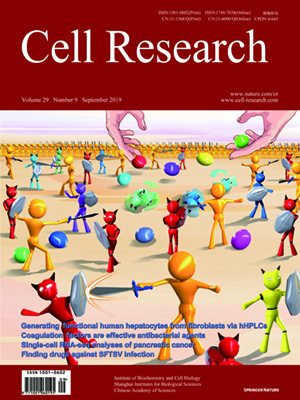
Volume 29, No 9, Sep 2019
ISSN: 1001-0602
EISSN: 1748-7838 2018
impact factor 17.848*
(Clarivate Analytics, 2019)
Volume 29 Issue 9, September 2019: 754-766 | Open Access
ORIGINAL ARTICLES
NDUFAB1 confers cardio-protection by enhancing mitochondrial bioenergetics through coordination of respiratory complex and supercomplex assembly
Tingting Hou1, Rufeng Zhang1, Chongshu Jian1, Wanqiu Ding1, Yanru Wang1, Shukuan Ling2, Qi Ma1, Xinli Hu1, Heping Cheng1 and Xianhua Wang 1
1 State Key Laboratory of Membrane Biology, Beijing Key Laboratory of Cardiometabolic Molecular Medicine, Peking-Tsinghua Center for Life Sciences, Institute of Molecular Medicine, Peking University, Beijing 100871, China and 2State Key Laboratory of Space Medicine Fundamentals and Application, China Astronaut Research and Training Center, Beijing 100094, China
Correspondence: Heping Cheng (chengp@pku.edu.cn) or Xianhua Wang (xianhua@pku.edu.cn)
The impairment of mitochondrial bioenergetics, often coupled with exaggerated reactive oxygen species (ROS) production, is a fundamental disease mechanism in organs with a high demand for energy, including the heart. Building a more robust and safer cellular powerhouse holds the promise for protecting these organs in stressful conditions. Here, we demonstrate that NADH:ubiquinone oxidoreductase subunit AB1 (NDUFAB1), also known as mitochondrial acyl carrier protein, acts as a powerful cardio-protector by conferring greater capacity and efficiency of mitochondrial energy metabolism. In particular, NDUFAB1 not only serves as a complex I subunit, but also coordinates the assembly of respiratory complexes I, II, and III, and supercomplexes, through regulating iron-sulfur biosynthesis and complex I subunit stability. Cardiac-specific deletion of Ndufab1 in mice caused defective bioenergetics and elevated ROS levels, leading to progressive dilated cardiomyopathy and eventual heart failure and sudden death. Overexpression of Ndufab1 effectively enhanced mitochondrial bioenergetics while limiting ROS production and protected the heart against ischemia-reperfusion injury. Together, our findings identify that NDUFAB1 is a crucial regulator of mitochondrial energy and ROS metabolism through coordinating the assembly of respiratory complexes and supercomplexes, and thus provide a potential therapeutic target for the prevention and treatment of heart failure.
https://doi.org/10.1038/s41422-019-0208-x
FULL TEXT | PDF
Browse 1284


